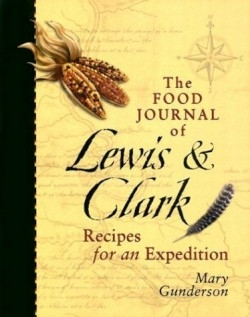
The Food Journal of Lewis & Clark
Recipes for an Expedition
A journal that records matters of food for an ambitious and dangerous mission concerns sustenance more than culinary refinement, and this book is such an endeavor. Logically, the author starts at the beginning of the expedition, with President Jefferson’s idea and the plans for the adventure, as documented in correspondence.
Gunderson, a food writer and culinary historian, holds a degree in Journalism with Food Science and Nutrition from Iowa State University. Her company, History Cooks, offers innovative food history books and lively presentations for kids and adults, bringing history alive through cooking.
Here, she is at her best when writing about the preparations for Lewis and Clark’s journey and the acquisition of supplies, foodstuffs, fine wine (the best in the United States), “brass kettles, tin tumblers, metal spoons, as well as beads, especially the China blues, to trade for food with tribal communities, cloth, writing materials, and equipment for hunting and fishing.” When Kentuckian William Clark joins the expedition at Lewis’ invitation, their joint travels begin.
Eighty recipes are accompanied by short, relevant, sidebars, which offer information that is usually fact, but sometimes fictional musing, such as: “Perhaps Lewis ate…with a lingering memory of fresh raspberry ice cream on a hot June day in Philadelphia.” Together, the recipes and brief comments make thoughtful reading. Along with the chronology of the journey, the recipes capture the progression from a rather rustic civilization into the wild, dangerous, and unpredictable.
Early recipes, like Virginia-style Beaten Biscuits from Jefferson’s table, represent a genteel life: “Few families enjoyed these biscuits if they didn’t have servants to spend twenty to thirty minutes beating air into the dough.” Mid-journey provisions are Hominy with Bacon, Greens with Salt Pork, and Camp White Fish, along with what the travelers can gather and catch. Charbonneau and Sacagawea join the travelers at Fort Mandan, and the food then reflects the influence of the new members of the party, the cold season, and the hardship. Here Gunderson provides recipes for Roast Buffalo with Sage, Parched Dried Corn, Dried Meat Soup, and Fort Mandan Pemmican, among others. The return to St. Louis at journey’s end also marks the return to culinary civilization and dishes like Standing Rib Roast, Nutmeg-Plum Shortcakes, and White Almond Cake with Lemon Curd.
The official cookbook of the Nation Council Lewis & Clark Bicentennial, this book appeals not only to historians and readers interested in food history, but also to persons who read broadly and deeply. Such readers will understand both the importance of the Lewis and Clark expedition and its ultimate effects, both obvious and subtle.
Reviewed by
Sally Ketchum
Disclosure: This article is not an endorsement, but a review. The publisher of this book provided free copies of the book to have their book reviewed by a professional reviewer. No fee was paid by the publisher for this review. Foreword Reviews only recommends books that we love. Foreword Magazine, Inc. is disclosing this in accordance with the Federal Trade Commission’s 16 CFR, Part 255.
